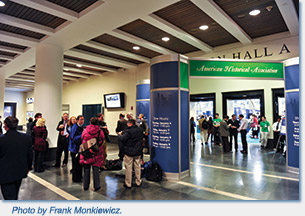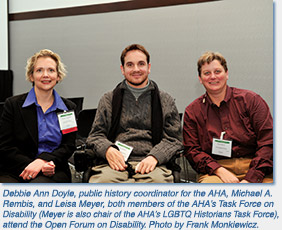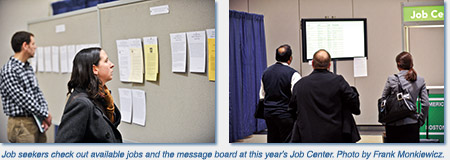 The 125th annual meeting (a particularly noteworthy anniversary!), held January 6–9, 2011, in Boston, was replete with the usual bustle of camaraderie, intellectual give-and-take, job search anxieties, often crowded receptions, film screenings, and even a fire alarm that sent attendees scurrying away from their sessions, job interviews, and the exhibit hall, albeit only for a little while. More than 5,000 registered to attend the meeting, including about 800 student members, many scholars from foreign countries, and a few student-teacher groups from local schools. We present below snapshots about the meeting, more to give an impressionistic picture than to comprehensively “cover” the meeting—an impossible task at any rate. Some more snapshots can be seen on the AHA blog, AHA Today, which also carries links to various blog posts commenting about the meeting, as well as to video coverage by C-SPAN of some sessions.
The 125th annual meeting (a particularly noteworthy anniversary!), held January 6–9, 2011, in Boston, was replete with the usual bustle of camaraderie, intellectual give-and-take, job search anxieties, often crowded receptions, film screenings, and even a fire alarm that sent attendees scurrying away from their sessions, job interviews, and the exhibit hall, albeit only for a little while. More than 5,000 registered to attend the meeting, including about 800 student members, many scholars from foreign countries, and a few student-teacher groups from local schools. We present below snapshots about the meeting, more to give an impressionistic picture than to comprehensively “cover” the meeting—an impossible task at any rate. Some more snapshots can be seen on the AHA blog, AHA Today, which also carries links to various blog posts commenting about the meeting, as well as to video coverage by C-SPAN of some sessions.
The Opening of the Meeting
The first formal event of the meeting was the presentation of the Seventh Theodore Roosevelt–Woodrow Wilson Public Service Award to Lee H. Hamilton, former Congressman, vice chair of the 9/11 Commission, and retired president and director of the Woodrow Wilson International Center for Scholars. This was followed by the plenary session, “History and the Public: A Session in Honor of Arnita Jones’s Commitment to the Public Work of Historians.” AHA Executive Director James Grossman chaired the session. Grossman spoke of Americans appetite for history, and how historians need a more active role in public culture to bring in the historical perspective. The panel included Leora Auslander (Univ. of Chicago), Wm. Roger Louis (Univ. of Texas at Austin), OAH president David A. Hollinger (Univ. of California at Berkeley), Linda K. Kerber (Univ. of Iowa), Juan R. I. Cole (Univ. of Michigan), and Anthony Grafton (Princeton Univ.). See the blog post at http://blog.historians.org/annual-meeting/1227/opening-of-the-125th-annual-meeting for details.
In actuality, the meeting had already begun before the formal opening, with several afternoon sessions held from 3 to 5 p.m. The first of these (as listed in the meeting Program) was a presentation by Dipesh Chakrabarty (Univ. of Chicago), which asked the question, “Does global climate change change history?” In his lucid but complex and nuanced discourse, Chakrabarty offered an insightful look into the history and historiography of human interaction with climate and geology, raising, in the process, significant and thought-provoking questions about the meaning of time scales, and the distinctions between the perceptions of humanists and natural scientists about climate change and its impact on human history. A video of a part of this presentation and a more detailed summary can be found on the History News Network web site.
The General Meeting
The highlight of Friday, January 8, was the General Meeting, which included the presentation of awards (see pages 15–24 of this issue for the details) and the presidential address, “Islam and Power in Colonial India: The Making and Unmaking of a Muslim Prince(ss),” delivered by Barbara Metcalf. In this lecture, which was illustrated by several fascinating images, Metcalf presented a rich-hued narrative about Shah Jahan Begum, a 19th-century ruler of Bhopal, a princely state in pre-independence India, and, in the process, offered a feminist history about a Muslim woman ruler while pointing to the misperceptions of Islamic culture and practices on the part of the British colonial official who oversaw Bhopal. The text of the address will appear in the February 2011 issue of the American Historical Review.
Public History at the Annual Meeting
In different ways many sessions at the meeting addressed issues relating to public history. Some were more directly relevant. Session 152, for example, “Making Equitable Tenure Decisions for Public History Faculty,” on Saturday, January 8 at 11:30 a.m., was devoted to discussion of the 2010 report endorsed by the governing boards of the American Historical Association, National Council on Public History, and Organization of American Historians. “The report, entitled “Tenure, Promotion, and the Publicly Engaged Academic Historian,” provides guidance to departments and administrators on the fair evaluation of public history. At the session, two recently tenured public historians offered advice on how to build a successful tenure case. Perhaps the most encouraging comment came from a member of the audience, who reported that several departments had referred to the report while interviewing her for positions teaching public history. The report can be found online at http://ncph.org/cms/wp-content/uploads/Engaged-Historian.pdf.
 Disability and History
Disability and History
The Open Forum on Disability on Friday, January 7, began with a rather too literal tearing down of barriers as hotel staff scrambled to make the head table accessible by removing a raised platform erected for a previous session. Nevertheless, panelists representing the joint AHA and Disability History Association (DHA) Task Force on Disability led a productive discussion of the task force’s preliminary findings and plans for its final report. Members noted that the task force’s survey of department chairs and directors of graduate studies revealed that most believed their universities had effectively provided accommodations for faculty and students with disabilities. A survey of historians with disabilities, however, revealed that only “constant, repetitive badgering” got them the accommodations they needed. The task force is also developing a mentoring program to match graduate students with disabilities with mentors who can offer them advice on navigating the profession and the job market.
The discussion was followed by a moving and emotional tribute to the life and work of Paul Longmore, a disability history scholar and activist who represented the DHA on the task force until his death in August 2010.
LGBTQ History
The vigorous discussion at the LGBTQ Historians Task Force Open Forum on Saturday, January 8, indicated anticipation for the final report of the task force, due in 2012. Those present challenged the AHA to actively promote equity for LGBTQ historians. In particular, members of the audience argued that LGBTQ historians need concrete and explicit information about whether potential employers offer a welcoming environment. Audience members suggested that the AHA might try to collect information on campus climates, or perhaps publish best practices for institutions wishing to foster a welcoming environment. Other concerns discussed include whether major journals in the field are adequately covering LGBTQ history in their articles and reviews, whether textbooks and primary source collections are incorporating research on LGBTQ history, and the difficulty of promoting equity in an environment where state and national laws allow or even encourage discrimination. Members of the joint AHA and Committee on Lesbian, Gay, Bisexual, and Transgender History (CLGBTH) LGBTQ Historians Task Force, which sponsored the session, distributed a draft of a survey to be circulated in the spring, producing an equally lively discussion on how to make the survey more effective.
Both the Open Forum on Disability and the LGBTQ Historians Task Force Open Forum included a discussion on how to effectively address equity issues within the existing structure of the Association. Leisa Meyer (Coll. of William & Mary), who serves on both task forces, pointed out that these questions touch on larger issues relating to the multiple vectors of discrimination.
The Job Center
 The 2011 Job Center was held in Ballroom A of the Hynes Convention Center. The space served us well, save for the fire alarm on Saturday, January 8, which interrupted interviews for about 15 minutes. Activity at the Job Center rebounded a bit after a down year at San Diego, as Job Center staff tracked 168 total searches at the 2011 meeting, compared to 115 for 2010. Sixty-five of those searches used the free tables in the ballroom (the rest of the searches used suites spread throughout the convention hotels), and at those tables they conducted 716 interviews, or an average of 11 interviews per search. The number of interviews per search has remained remarkably constant in recent years. As usual, the highest traffic day at the Job Center was Friday, January 7, the first full day of the annual meeting.
The 2011 Job Center was held in Ballroom A of the Hynes Convention Center. The space served us well, save for the fire alarm on Saturday, January 8, which interrupted interviews for about 15 minutes. Activity at the Job Center rebounded a bit after a down year at San Diego, as Job Center staff tracked 168 total searches at the 2011 meeting, compared to 115 for 2010. Sixty-five of those searches used the free tables in the ballroom (the rest of the searches used suites spread throughout the convention hotels), and at those tables they conducted 716 interviews, or an average of 11 interviews per search. The number of interviews per search has remained remarkably constant in recent years. As usual, the highest traffic day at the Job Center was Friday, January 7, the first full day of the annual meeting.
Thirty-five of the 168 searches were open and were collecting c.v.’s at the annual meeting (21 percent). This is the lowest percentage of open searches in at least five years, though not by much. Usually about a quarter of the total searches are open.
U.S. history was the field with most openings—43 of the 168 searches were in that field, broadly defined. European history was second with 29 searches, while Asia had 23, thematic history had 16, world history had 15, Africa 12, Latin American 11, and Middle Eastern history had 8 searches. Each field other than thematic history (which remained the same) had more searches conducting interviews at the 2011 annual meeting than at the 2010 San Diego meeting.
The Film Festival
The AHA held its fifth consecutive Film Festival during the 125th Annual Meeting. Eight films were screened during the festival. With the exception of the John O’Connor Film Award-winner (The Most Dangerous Man in America: Daniel Ellsberg and the Pentagon Papers), all were based on the meeting theme, “History, Society, and the Sacred.” Three of the films—God in America, Freedom Riders, and Tecumseh’s Vision from We Shall Remain: America Through Native Eyes—were produced by WGBH for its American Experience television series.
All screenings were well attended, some more than others (mostly likely due to scheduling conflicts). The most popular screening was of Freedom Riders on Friday evening, which was standing-room only. All of the screenings concluded with Q & A sessions with either the filmmakers or an academic connected to the film’s subject matter. Unfortunately the filmmaker of the first film, The Heavenly Court in Song Family Village: Gender, Hierarchy, and Religious Power in a North China Village, could not attend the meeting at the last minute and the AHA hopes to provide an online discussion for that film on its web site in the near future.
The AHA hopes to continue the film festival for the 126th Annual Meeting in Chicago. The 2012 AHA Program Committee is seeking suggestions for films to screen at the annual meeting in Chicago. Historians who have worked as consultants on recent films and would be willing to lead a discussion at the meeting are invited to propose a screening. Suggestions for films that complement the meeting theme, “Communities and Networks,” are also encouraged. Films may be either documentaries or feature films, from inside or outside of the United States. Send suggestions to Debbie Ann Doyle. Please include the name of the film; the name(s) of the producer, director, and writer; year of release; the name of the production company; the name and affiliation of the proposed discussant (if any); and contact information for the production company or distributor. Please submit suggestions by March 15, 2011.
The Conspirator at the Meeting
On Saturday evening the American Film Company (TAFC) sponsored a screening of its film, The Conspirator. The film follows the trial of Mary Surratt, the lone female accused of taking part in the conspiracy to assassinate President Lincoln, and tells the story of Frederick Aiken, the lawyer responsible for defending her. James Grossman, AHA’s executive director, introduced Joe Ricketts, the founder of TAFC, stating that while the AHA did not endorse the film, he saw the event as an opportunity for historians to understand the filmmaking process and to become more involved in the goal of TAFC, which is to make entertaining films that are as historically accurate as possible. Joe Ricketts shared his passion for film and the reasons behind starting the company. After the screening, a panel discussion was held with Grossman serving as the moderator. The panelists included consulting historians Fred R. Borch, Kate Clifford Larson, and Thomas R. Turner, as well as one of the film’s producers, Webster Stone, and the screenwriter James D. Solomon.
During the discussion, audience members asked questions about the validity of different parts of the story. When asked about omitting the subject of slavery the screenwriter stated that that it was a conscious decision. He went on to say that he started writing the film 18 years ago and what drew him to the story was the relationship between a mother and son and that’s what he focused on as he wrote the screenplay. TAFC will have an educational resource guide available on its web site in the near future. The AHA welcomes feedback from its members on whether we should have such screenings in the future. Feel free to send us your comments.
 The Exhibit Hall
The Exhibit Hall
Always a popular feature, the book exhibit this year had 91 exhibiting companies occupying 126 booths (including, of course the two booths of the AHA). As usual, meeting attendees thronged outside the exhibit hall, located in the Hynes Convention Center, waiting for the doors to open each day, to browse through the many books on show or to pick up deeply discounted copies of numerous books, old and new.
Compiled by Pillarisetti Sudhir, with contributions from David M. Darlington, Debbie Ann Doyle, Kelly Elmore, Elisabeth Grant, and Chris Hale.
Tags: Annual Meeting
Comment
Please read our commenting and letters policy before submitting.






